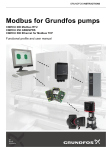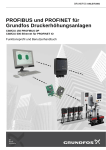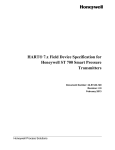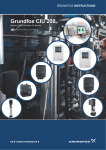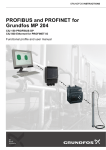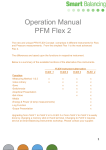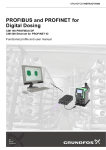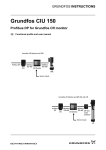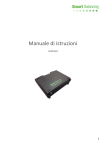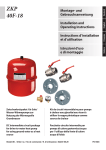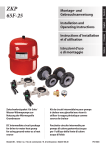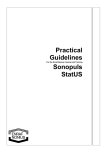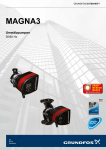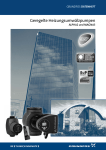Download PDF
Transcript
GRUNDFOS INSTRUCTIONS PROFIBUS and PROFINET for Grundfos pumps CIM/CIU 150 PROFIBUS DP CIM/CIU 500 Ethernet for PROFINET IO Functional profile and user manual English (GB) English (GB) Functional profile and user manual 1. Symbols used in this document Original functional profile and user manual. CONTENTS Warning Page 1. Symbols used in this document 2 2. 2.1 2.2 2.3 2.4 2.5 Introduction About this functional profile PROFIBUS DP-V0 PROFIBUS DP-V1 Assumptions Definitions and abbreviations 3 3 3 3 3 3 3. 3.1 3.2 3.3 System description PROFIBUS/PROFINET PROFIBUS DP (CIM 150) PROFINET IO (CIM 500) 4 4 4 4 4. 4.1 4.2 4.3 Specifications CIM module general data CIM 150 PROFIBUS DP CIM 500 PROFINET IO 5 5 5 5 5. 5.1 5.2 5.3 5.4 5.5 5.6 5.7 5.8 PROFIBUS DP, CIM 150 setup PROFIBUS bus topology CIM 150 PROFIBUS module Connecting the PROFIBUS Setting the PROFIBUS address Termination resistors Status LEDs Communication watchdog Reaction to PLC "Stop button" 6 6 6 6 7 7 7 7 7 6. 6.1 6.2 6.3 6.4 6.5 6.6 PROFINET IO, CIM 500 setup Connecting the Ethernet cable Setting the Industrial Ethernet protocol Setting up the IP addresses Establish connection to the Webserver Status LEDs DATA and LINK LEDs 8 8 8 8 9 9 9 7. 7.1 7.2 7.3 7.4 7.5 7.6 Detailed description of data modules Data types Control module (controlModule, module 2) Status module (StatusModule, module 1) Illustration of closed-loop control Relay control module (RelayControl, module 3) Setting of the maximum flow limit (SetMaxFlowLimit, module 44) 7.7 Setting of the real-time clock (SetRealTimeClock, module 45) 7.8 Alarms and warnings 7.9 Measurement data modules 7.10 Sensor-dependent measurements 7.11 Device identification (DeviceIdentification, module 41) 14 15 16 19 20 8. 8.1 8.2 Product simulation CIM 150 Product Simulation CIM 500 Product Simulation 21 21 21 9. 9.1 9.2 Fault finding CIM/CIU 150 CIM/CIU 500 22 22 23 10. Grundfos alarm and warning codes 24 11. PROFIBUS address 27 2 10 10 10 12 14 14 14 If these safety instructions are not observed, it may result in personal injury. Caution If these safety instructions are not observed, it may result in malfunction or damage to the equipment. Note Notes or instructions that make the job easier and ensure safe operation. 2.1 About this functional profile This functional profile describes the: • CIM/CIU 150 PROFIBUS DP • CIM/CIU 500 Ethernet for PROFINET IO for the following Grundfos products: • Grundfos CRE/CRNE/CRIE, MTRE, CHIE, CME • Grundfos TPE, TPE Series 2000, NBE/NKE • Grundfos CUE drive • Grundfos MAGNA (with add-on GENIbus module) • Grundfos MAGNA3 • Grundfos UPE Series 2000 (UPE 80-120 and 100-120). Grundfos GO A Grundfos handheld remote control device for controlling Grundfos products via infrared or radio. Based on smart phone technology. H Pressure (head). HTTP Hyper Text Transfer Protocol. The protocol commonly used to navigate the world wide web. IANA Internet Assigned Numbers Authority. IP Internet Protocol LED Light-Emitting Diode. Local mode The E-pump uses the setpoint and operating mode set with a handheld remote control (R100 or Grundfos GO Remote) or by the use of buttons on the pump. MAC Media Access Control. Unique network address for a piece of hardware. Ping Packet InterNet Groper. A software utility that tests connectivity between two TCP/IP hosts. 2.2 PROFIBUS DP-V0 Q Flow. The PROFIBUS DP interface conforms to the PROFIBUS DP-V0 standard for cyclic data transmission. R100 Grundfos handheld infrared remote control. The option of setting the PROFIBUS DP address via bus is not supported as the CIM 150 has two switches for setting the address. Remote mode The E-pump uses the setpoint and operating mode set from PROFIBUS. In the following, the supported products are referred to as "E-pump". The data in this document are subject to change without prior notice. Grundfos cannot be held responsible for any problems caused directly or indirectly by using information in this functional profile. SELV Separated or Safety Extra-Low Voltage. 2.3 PROFIBUS DP-V1 SELV-E Separated or Safety Extra-Low Voltage with Earth connection. Only the diagnostic part and the extra three bytes of parameterisation data are supported. Acyclic data transmission is not supported. SMA SubMiniature version A. Coaxial radio signal cable connection standard. 2.4 Assumptions This functional profile assumes that the reader is familiar with commissioning and programming of PROFIBUS and PROFINET devices. SMTP Simple Mail Transfer Protocol SNTP Simple Network Time Protocol. Used for clocks synchronization between computer systems. TCP Transmission Control Protocol. Protocol suitable for Internet communication and Industrial Ethernet communication. TCP/IP Transmission Control Protocol/Internet Protocol. Protocol suitable for Internet communication. 2.5 Definitions and abbreviations ARP Address Resolution Protocol. Translates IP-addresses to MAC-addresses Transmission speed Bits transferred per second, bits/s. Auto-MDIX Ensures that both crossover cable types and non-crossover cable types can be used. URL Uniform Resource Locator. The address used to connect to a server. CAT5 Ethernet cable type: Has 4 twisted pairs of wires. UTC Coordinated Universal Time, the primary time standard by which the world regulates clocks and time. CAT5e Enhanced CAT5 cable with better performance. UTF-8 Unicode Transformation Format (character encoding). CAT6 Cable with very high performance. CIM Communication Interface Module. CIU Communication Interface Unit. Cyclic Redundancy Check, a data error detection method. VPN CRC DHCP Dynamic Host Configuration Protocol. Used to configure network devices so that they can communicate on an IP network. Virtual Private Network.A network using the Internet to connect nodes. These systems use encryption and other security mechanisms to ensure that only authorised users can access the network and that the data cannot be intercepted. DNS Domain Name System. Used to resolve host names to IP addresses. Enumeration List of values. GENIbus Proprietary Grundfos fieldbus standard. GENIpro Proprietary Grundfos fieldbus protocol 3 English (GB) 2. Introduction 3.1 PROFIBUS/PROFINET The system diagrams give an overview of how to connect the CIM/CIU 150 or CIM/CIU 500 to the Grundfos E-pump that is to be connected to a PROFIBUS or PROFINET network. CIM The CIM module is an add-on communication module that is to be fitted internally in a Grundfos E-pump, using a 10-pin connection. In this setup, the E-pump will supply power to the CIM module. See fig. 1 and fig. 3. CIU The CIU unit is a box incorporating a power supply module and a CIM 150/500 module. It can either be mounted on a DIN rail or on a wall. See fig. 2 and fig. 4. The CIU 150/500 is used in conjunction with a Grundfos E-pump that does not support an internal, add-on communication module (CIM module). The enclosure class is IP54. 3.2 PROFIBUS DP (CIM 150) 9 CIM 150 PROFIBUS Modbus RTU DP RS-485 5 6 7 Example of a CIM 150 solution. The CIM module is installed inside the pump. The figure shows a CRE pump. PROFIBUS DP GENIbus RS485 CIU 150 Fig. 2 TM05 74391013 Fig. 1 4 TM04 2295 2208 8 1 2 3 Example of a CIU 150 solution. The figure shows a CUE-drive for pumps. 3.3 PROFINET IO (CIM 500) TM05 7431 1013 CIM 500 PROFINET IO Fig. 3 Example of a CIM 500 solution. The CIM module is installed inside the pump. The figure shows a CRE pump. PROFINET IO GENIbus RS485 CIU 500 Fig. 4 4 Example of a CIU 500 solution. The figure shows a CUE-drive for pumps. TM05 7452 1013 English (GB) 3. System description English (GB) 4. Specifications 4.1 CIM module general data General data Description Comments Ambient humidity 30 % to 95 % Relative, non-condensing. Operating temperature -20 °C to +45 °C Storage temperature -25 °C to +70 °C GENIbus visual diagnostics LED2 Will be in one of these states: Off, constantly green, flashing red, constantly red. See section 5.6 for PROFIBUS DP and section 6.5 for PROFINET IO. Power supply (CIU) 24-240 V Located in the CIU. GENIbus connection type (CIU) RS-485, 3-wire + screen Conductors: A, B and Y. CIU box enclosure class IP54 CIU box dimensions (H x W x D) 182 x 108 x 82 mm 4.2 CIM 150 PROFIBUS DP The table below provides an overview of the specifications for the Grundfos CIM 150 and CIU 150. For further details, please refer to the specific sections of this functional profile. General data Description Comments PROFIBUS implementation class DP-V0 Intelligent pump profile. PROFIBUS connector Screw-type terminal A, B, DGND, VP (+5 V). PROFIBUS connection type RS-485, two-wire Conductors: A, B. Maximum cable length 100 metres at 12 Mbits/s Corresponds to 328 feet. See section 5.3.1 Data transmission rates and cable length. Slave address 1-126 Set via rotary switches SW3 and SW4. See section 5.4 Setting the PROFIBUS address. Line termination On or off Set via DIP switches SW1 and SW2. See section 5.5 Termination resistors. Auto detected Recommended cable cross sectional cobber area 0.20 - 0.25 mm2 AWG24 or AWG23 Supported transmission speed 9.6 Kbits/s to 12 Mbits/s Auto detected. PROFIBUS visual diagnostics LED1 Off, constantly green, flashing red, constantly red. See section 5.6 Status LEDs. Maximum number of PROFIBUS devices at a physical network segment. 32 Up to 125 devices if repeaters are used (physically segmented network). 4.3 CIM 500 PROFINET IO The table below provides an overview of the specifications for the Grundfos CIM/CIU 500 Ethernet for PROFINET IO. For further details, please refer to the specific sections of this functional profile. Modbus TCP specifications Description Comments Application layer DHCP, HTTP, Ping, FTP, SMTP, SNTP, PROFINET IO Rotary switch in position 0. Transport layer TCP Internet layer Internet protocol V4 (IPv4) Link layer ARP, Media Access Control (Ethernet) Ethernet cable Screened/unscreened, twisted-pair cables, CAT5, CAT5e or CAT6 Maximum cable length 100 metres at 10/100 Mbits/s Corresponds to 328 feet. Transmission speed 10 Mbits/s, 100 Mbits/s Auto-detected. Industrial Ethernet protocols PROFINET IO, Modbus TCP Selected with rotary switch, section 6.2. Supports auto cable-crossover detecting (Auto-MDIX) 5 Note The power supply (pos. 4, fig. 6) must only be used for external termination. 5.1 PROFIBUS bus topology LT LT Fig. 5 Slave Slave Master Slave TM04 9635 4810 The PROFIBUS-preferred bus topology is daisy chaining as illustrated in fig. 5. The end devices of a physical bus segment must be terminated (LT = Line Termination). Each device must have a unique physical address [1-126]. Up to 32 PROFIBUS devices can be connected to a bus segment, and by using a repeater another 32 devices can be connected. This can be repeated until the maximum number of addresses are used. Make sure that each device is connected to a proper earth potential. Example of PROFIBUS bus segment with line termination 5.2 CIM 150 PROFIBUS module 5.3 Connecting the PROFIBUS 5.3.1 Data transmission rates and cable length Grundfos recommends to use a cable according to IEC 61158. Example Siemens, 6XV1 830-0EH10. Cable length Maximum cable length kbits/s [m/ft] 9.6 1200/4000 19.2 1200/4000 45.45 1200/4000 93.75 1000/3300 187.5 1000/3300 500 400/1300 1500 200/660 3000 100/330 6000 100/330 12000 100/330 Fitting the cable See fig. 7. 1. Connect the red conductor(s) to terminal B (pos. 1). 2. Connect the green conductor(s) to terminal A (pos. 2). 3. Connect the cable screens to earth via the earth clamp (pos. 3). 8 9 1 2 3 4 Fig. 6 5 6 7 Note TM04 1699 0908 For maximum safety and reliability, connect the cable screen to earth via the earth clamp, and make sure that all CIU 150 units are properly earthed via the mains supply earth wire. 4 5 CIM 150 PROFIBUS module 2 1 Pos. Designation Description 1 B (RxD/TxD-P) PROFIBUS terminal B (positive data signal) 2 A (RxD/TxD-N) PROFIBUS terminal A (negative data signal) 3 DGND PROFIBUS terminal DGND (only for external termination) 4 VP +5 VDC (only for external termination) Pos. PROFIBUS terminal B SW1/SW2 On/off switches for termination resistors 1 2 PROFIBUS terminal A LED1 Red/green status LED for PROFIBUS communication 3 Earth clamp 4 +5 VDC 5 DGND 7 LED2 Red/green status LED for GENIbus communication between the CIM/CIU 150 and the E-pump 8 SW3 Hex switch for setting the PROFIBUS address (four most significant bits) 9 SW4 Hex switch for setting the PROFIBUS address (four least significant bits) 5 6 6 3 Fig. 7 Connecting the PROFIBUS Description TM04 1700 0908 English (GB) 5. PROFIBUS DP, CIM 150 setup 5.4 Setting the PROFIBUS address The CIM 150 PROFIBUS module has two hexadecimal rotary switches for setting the PROFIBUS address. The two switches are used for setting the four most significant bits (SW3) and the four least significant bits (SW4), respectively. See fig. 8. Fig. 8 SW4 Note The PROFIBUS address must be set decimally from 1 to 126. The address 126 is normally used for special purposes and should not be used. PROFIBUS address SW3 SW4 8 0 8 20 1 4 SW2 Cut in ON ON Cut out OFF OFF ON OFF OFF ON Note Setting the PROFIBUS address The table below shows examples of PROFIBUS address settings. SW1 Undefined state TM04 1702 0908 SW3 Status To ensure stable and reliable communication, it is important that only the termination resistors of the first and last units in the PROFIBUS network are cut in. 5.6 Status LEDs The CIM 150 PROFIBUS module has two LEDs. See fig. 6. • Red/green status LED (LED1) for PROFIBUS communication. • Red/green status LED (LED2) for GENIbus communication between the CIM/CIU 150 and the connected E-pump. LED1 31 1 F Status 126 7 E Off. The CIM 150 has been switched off. Constantly green. The CIM 150 is ready for PROFIBUS data transmission (Data Exchange State). Constantly red. CIM 150 module fault. The CIM 150 does not support the connected E-pump. Flashing red. Wrong or missing PROFIBUS configuration or no contact to the PROFIBUS master. A restart of the CIM/CIU 150 has to be performed for a PROFIBUS address change to take effect. For complete overview of the PROFIBUS addresses, see section 11. PROFIBUS address. 5.5 Termination resistors The termination resistors are fitted on the CIM 150 PROFIBUS module. See fig. 9. Description LED2 +5V 220 Status SW1 SW2 390 TM04 1961 1508 390 Fig. 9 English (GB) DIP switch settings Off. The CIM 150 is switched off. Constantly green. GENIbus communication between the CIM 150 and the E-pump is OK. Constantly red. The CIM 150 does not support the connected E-pump. Flashing red. No GENIbus communication between the CIM 150 and the E-pump. Internal termination resistors SW1 SW2 Fig. 10 Cutting termination resistors in and out TM04 1703 0908 The CIM 150 has a DIP switch with two switches (SW1 and SW2) for cutting the termination resistors in and out. Figure 10 shows the DIP switches in cut-out state. Description Note During start-up, there may be a delay of up to 5 seconds before the LED2 status is updated. 5.7 Communication watchdog The state of the PROFIBUS communication watchdog can be changed with a PROFIBUS commissioning tool, e.g. Siemens Simatic Manager. If the watchdog is enabled, all bits in the ControlModule (see section 7.2 Control module (controlModule, module 2)) are automatically set to "0" if the PROFIBUS communication is broken. As a result, the E-pump will be set to local mode and then be operating according to the local operating mode, local setpoint and local control mode. 5.8 Reaction to PLC "Stop button" If the PLC is stopped by the operator, all output registers will be set to "0". As a result, the control bit RemoteAccessReq will be cleared, and the E-pump will be set to local mode and then be operating according to the local operating mode, local setpoint and local control mode. 7 6.2 Setting the Industrial Ethernet protocol 6.1 Connecting the Ethernet cable The CIM 500 Ethernet module has a rotary switch for selection of the Industrial Ethernet protocol. See fig. 13. Warning The CIM 500 must only be connected to SELV or SELV-E circuits. TM05 7481 1013 RJ45 plugs and Ethernet cable must be used. The cable shield must be connected to protective earth at both ends. It is important to connect cable shield to earth through earth clamp or to connect cable shield to earth in the connector. Note The CIM 500 is designed for flexible network installation; the built-in two port switch makes it possible to daisy chain from product to product without the need of additional Ethernet switches. The last product in the chain is only connected to one of the Ethernet ports. Each Ethernet port has its own MAC address. CIM 500 TM05 6435 4711 Ethernet switch CIM 500 CIM 500 CIM 500 Fig. 13 Selecting the Industrial Ethernet protocol Pos. Description 0 PROFINET IO (Default from factory) 1 Modbus TCP 2..E Reserved, LED1 will be permanently red to indicate an invalid configuration F Reset to factory default Note: The rotary switch has to be set in this position for 20 seconds before the CIM 500 resets to factory default. During this period LED1 will be flashing red and green at the same time to indicate that a reset will occur. Fig. 11 Example of Industrial Ethernet network Note Every change of the rotary switch, when the module is powered on, will cause the module to restart. 6.3 Setting up the IP addresses The CIM 500 Ethernet module is default set up to a fixed IP address. It is possible to change the IP address settings from the built in web server. 2 3 1 4 5 6 7 8 TM05 7431 1013 English (GB) 6. PROFINET IO, CIM 500 setup 9 Fig. 12 Example of Ethernet connection (CIM 500) Pos. 8 Description Designation 1 Industrial Ethernet RJ45 Connector 1 ETH1 2 Industrial Ethernet RJ45 Connector 2 ETH2 3 Rotary switch for protocol selection SW1 4 Data activity LED for Connector 1 DATA1 5 Link LED for Connector 1 LINK1 6 Data activity LED for Connector 2 DATA2 7 Link LED for Connector 2 LINK2 8 Green/red status LED for Ethernet communication LED 1 9 Green/red status LED for internal communication between module and pump. LED 2 Default IP settings used by web server IP address:192.168.1.100 Subnet mask: 255.255.255.0 Gateway: 192.168.1.1 IP-settings for Modbus TCP Must be setup by the Web server Device name and IP settings for PROFINET IO Static configuration from Web server or configuration from PROFINET IO configuration tool. 6.4 Establish connection to the Webserver The CIM 500 module can be configured using the built-in Web server. To establish a connection from a PC to CIM 500 the following steps are required: Status • Connect the PC and the CIM 500 module using an Ethernet cable • Configure the PC Ethernet port to the same subnetwork as the CIM 500, e.g. 192.168.1.101, and the subnet mask to 255.255.255.0. See section A.2 Web server configuration on page 28. • Open a standard Internet browser and type 192.168.1.100 in the URL field. • Log in to the Web server using: User The CIM 500 is switched off. Flashing red No internal communication between the CIM 500 and the Grundfos product. Permanently red The CIM 500 does not support the Grundfos product connected. Permanently green Internal communication between the CIM 500 and the Grundfos product is OK. Permanently red and green Memory fault. Note User and password may have been changed from their factory default values. TM05 6436 4712 Note Grundfos (default) Fig. 14 CIM 500 connected to PC Description Off admin (default) Password English (GB) LED2 During start-up, there is a delay of up to 5 seconds before LED1 and LED2 status is updated. 6.6 DATA and LINK LEDs The CIM 500 Ethernet module has two connectivity LEDs related to each RJ45 Connector. See fig. 12. DATA1 and DATA2 These yellow LEDs indicate data traffic activity. Status Description Yellow off No data communication on RJ45 Connector. Note Both ETH1 and ETH2 can be used to establish a connection to the Web server. Yellow flashing Data communication ongoing on RJ45 Connector. Note The web server can be accessed while the selected Industrial Ethernet protocol is active. Steady yellow Heavy network traffic on RJ45 connector. LINK1 and LINK2 6.5 Status LEDs The CIM 500 Ethernet module has two Status LEDs, (LED1 and LED2). See fig. 12. • Red/green status LED (LED1) for Ethernet communication • Red/green status LED (LED2) for internal communication between the CIM 500 and the Grundfos product. These green LEDs shows whether the ethernet cable is properly connected. Status Description Green off No Ethernet Link on RJ45 Connector Green on Ethernet Link on RJ45 Connector is OK LED1 Status Description Off The CIM 500 is switched off. Flashing green Wink function. LED will flash 10 times when activated from master. Permanently green The CIM 500 is ready for data transmission (data exchange state). Flashing red (3 Hz, duty cycle 50 %) Wrong or missing PROFINET IO configuration. See section CIM 500 fitted in a Grundfos E-pump. Pulsing red (0.3Hz, duty cycle 10%) Configured, but connection to master lost. See section CIM 500 fitted in a Grundfos E-pump. Permanently red Product not supported. See section CIM 500 fitted in a Grundfos E-pump. Permanently red and green Error in firmware download. See section CIM 500 fitted in a Grundfos E-pump. Flashing red and green After 20 seconds in this state, the CIM 500 factory settings are restored and the device is restarted. 9 English (GB) 7. Detailed description of data modules + CUE frequency converter, MGE model H/I and MAGNA3 only. * 7.1 Data types MAGNA3 and LME series 2000 only. ** MAGNA and LME series 2000 only. The Grundfos CIM 150/500 supports the following data types. All data types, except for data type 10, comply with specification IEC 61158-6 standard data types for use in PROFIBUS/ PROFINET profiles. 7.2.1 Explanation to event trigger Rising edge Data type Description 1 Boolean 2 Integer 8 Control bits with a rising-edge event trigger behave like a command that is executed when a bit transition from "0" to "1" occurs. Each of them has a corresponding acknowledge bit in the StatusModule which is set when the command is executed and cleared when the control bit is written back to "0". 3 Integer 16 State 4 Integer 32 5 Unsigned 8 6 Unsigned 16 7 Unsigned 32 8 Floating point 9 Visible string 10 Non-standard Control bits with a state event trigger behave like a "state" that is forced upon the E-pump. In the CIM/CIU, the "actual state" of the E-pump as read from the StatusModule is continuously compared with the "requested" state in the ControlModule, and the CIM/CIU writes the appropriate GENIbus command to the E-pump to make the two states correspond to each other. Due to state restrictions or priorities, this might not always be possible (see explanation to the bit in question). 7.2.2 Explanation to control bits All multi-byte data types are transmitted with MSB (Most Significant Byte) first. RemoteAccessReq 7.2 Control module (controlModule, module 2) The control module is a PROFIBUS/PROFINET output module used for the control of E-pumps. Its data type is 10, non-standard. Byte Byte 1 (data type 5) Name Event trigger 0 RemoteAccessReq State 1 OnOff State 2 ResetFault Rising edge 3 - - 4 CopyToLocal+ State - - Bit 5-7 1: ConstFreq OnOff 2: - Control bit used to start and stop the E-pump: 4: ConstPressure 5: ConstDiffPress 1: For starting the E-pump remotely. ResetFault 7: ConstFlow Control bit that resets alarms and warnings. 8: ConstTemp CopyToLocal 9: ConstTempDiff Control bit for making the E-pump copy its remote setting of operating mode, setpoint and control mode to its local settings. Whenever this bit is set, switching the E-pump from remote to local (i.e. like the PROFIBUS/PROFINET watchdog does) will not influence the behaviour of the E-pump. 11-127: 128: AUTOADAPT (AutoPressMode)** 129: FLOWADAPT* 130: Closed loop sensor OperatingMode [enumeration] 0: AutoControl 1-3: 4: OpenLoopMin 5: 6: OpenLoopMax 10 0: For stopping the E-pump remotely. 6: VarDiffPress 10: ConstLev Byte 4 and 5 (data type 6) 1: The E-pump will be set to remote mode and operate according to the operating mode, setpoint and control mode set in the ControlModule. The other control bits in the ControlModule will also be active. 0: ConstSpeed 3: ConstHead Byte 3 (data type 5) 0: The E-pump will be set to local mode and operate according to its local operating mode, setpoint and control mode. With this setting, the other control bits in the ControlModule will have no influence. However, certain commands from other control sources (e.g. Stop or Max. from a local source or external Stop from a digital input) have higher priority and will overrule the control from the bus. The AccessMode bit in StatusModule will have the value "0" if this is the case. See section 7.3.1 Explanation to status module. ControlMode [enumeration] Byte 2 (data type 5) Control bit for setting the E-pump in remote mode (controlled from bus) or local mode (controlled from panel/R100/ Grundfos GO): Setpoint [0.01 %] 0: Copy to local settings inactive. 1: Copy to local settings active. English (GB) 7.2.3 Explanation to control mode Control enumeration for selection of the remote control mode. Control modes Description Illustration > ConstSpeed (0) > ConstFreq (1) The setpoint of the E-pump is a percentage of the maximum performance. No sensor is required, and in these modes the E-pump is operating in open-loop control. Q TM04 2289 2208 H Q > ConstFlow (7) > ConstTemp (8) > ConstLev (10) The setpoint of the E-pump will be interpreted as setpoint for the flow, temperature or level. ConstFlow is indicated in the figure. In these modes, the E-pump is operating in closed-loop control, and a relevant sensor is required: • a temperature sensor for temperature control • a level sensor for level control • a flow sensor for flow control. H Q TM04 2288 2208 > ConstHead (3) > ConstPressure (4) > ConstDiffPresure (5) TM04 2290 2208 H The setpoint of the E-pump will be interpreted as setpoint for the pressure. In these modes, the E-pump is operating in closed-loop control and will adapt its speed so that the pressure is constant, regardless of the flow. A pressure sensor is required. > VarDiffPress (6) The setpoint of the E-pump will be interpreted as a proportional-pressure setpoint as shown in the figure. This is a closed-loop control mode, and a pressure sensor is required. Q TM04 2291 2208 H > AUTOADAPT (128) Q TM05 3241 1012 H In this control mode, the setpoint curve is a proportional-pressure curve where the setpoint has been set from factory. The AUTOADAPT algorithm in the pump will over time optimise the setpoint value according to the pipe characteristics of the system. The setpoint curve will always be adjusted in a downward direction. > FLOWADAPT (129) This control mode works similar to AUTOADAPT, except that the flow-limiting function, FLOWLIMIT, is always active and limits the flow to the value ActualMaxFlowLimit (data module 46). Q > Closed loop sensor TM05 3242 1012 H This is a general purpose closed loop control mode, that can be used in cases where the pump is used for a type of control not covered by one of the other control modes. H = Pressure (head) Q = Flow Important notes to control mode Only valid control modes will be accepted. Not all control modes are supported for all E-pump types. If not supported, the resulting control mode, as read from the StatusModule(module 1) will remain equal to the last valid control mode set via PROFIBUS/ PROFINET. 11 Example of open loop Control enumeration for selection of the remote operating mode. If the control mode is set to ConstFreq, the setpoint is interpreted as setpoint for the E-pump performance. 0: AutoControl This is the normal mode. The E-pump is controlled according to the selected control mode and setpoint. See section 7.2.3 Explanation to control mode. Maximum pump performance 4: OpenLoopMin The E-pump operates at a fixed minimum frequency. 6: OpenLoopMax The E-pump operates at a fixed maximum frequency. Closed loop The 16-bit data item Setpoint accepts values ranging from 0-10000 corresponding to 0-100 % of feedback sensor maximum value. 0=0% The Setpoint can represent speed, pressure, flow, etc., depending on the selected control mode which must match the selected sensor. The status module is an input module used for reading status from E-pumps. Its data type is 10, non-standard. Sensor maximum Byte 10000 = 100 % TM04 2373 2508 Setpoint [%] Fig. 15 Closed-loop Setpoint If the control mode is set to ConstPress, and the pressure sensor range is 0-10 bar, a setpoint of 80 % will result in an effective setpoint of 8 bar. If the sensor range was 0-16 bar, a 50 % setpoint would be 8 bar, a 25 % setpoint would be 4 bar, and so on. 0 AccessMode 1 OnOff 2 Fault AtMaxSpeed 6 - 7 AtMinSpeed 0-2 - 3 ResetFaultAck The 16-bit data item Setpoint accepts values ranging from 0-10000 corresponding to 0-100 % of the E-pump performance (frequency). Some E-pump types have a configurable maximum frequency limit. If this limit has been set to a value lower than the frequency stated on the nameplate, a performance of 100 % cannot be attained. AtMaxPower* 6 Rotation 7 Direction Byte 5 (data type 5) Byte 6 (data type 5) OperatingMode [enumeration] 0: AutoControl 1-3: 4: OpenLoopMin 5: 6: OpenLoopMax Fig. 16 Example of setpoint for constant pressure, with a pressure sensor range of 0-10 bar Open loop SetPointInfluence ControlMode [enumeration] 0: ConstSpeed 1: ConstFreq 2: 3: ConstHead 4: ConstPressure 5: ConstDiffPress 6: VarDiffPress 7: ConstFlow 8: ConstTemp 9: ConstTempDiff 10: ConstLevel 11-127: 128: AUTOADAPT ** (AutoPressMode) 129: FLOWADAPT* 130: Closed loop sensor TM04 2371 2508 10000 = 100 % - 5 ProcessFeedback [0.01%] 8 bar 8000 = 80 % Warning Bytes 3 and 4 (data type 6) 10 bar 12 Name 4 Byte 2 (data type 5) 5 Example of closed loop Note Bit 3 Byte 1 (data type 5) 4 0=0% 10000 = 100 % 7.3 Status module (StatusModule, module 1) A setpoint of 0 does not imply a stop. 0=0% 5000 = 50 % Fig. 17 Example of setpoint for constant frequency This is illustrated in fig. 15. * MAGNA3 and LME series 2000 pumps only. ** MAGNA and LME series 2000 pumps only. TM04 2372 2508 50 % pump performance 7.2.5 Explanation to Setpoint Effective setpoint English (GB) 7.2.4 Explanation to operating mode ResetFaultAck AccessMode Acknowledge bit belonging to the ResetFault control bit. It will be set when the control bit is set and the command has been executed. It will be cleared when the control bit is cleared. Status bit indicating whether the E-pump is controlled from the bus or from some other control source. 0: The E-pump is controlled from a local source (buttons, R100, Grundfos GO) or from an external digital input. 1: The E-pump is controlled from PROFIBUS/PROFINET (remotely). To allow the E-pump to be controlled from the bus, the RemoteAccessReq control bit in the ControlModule must be set to "1". However, certain commands from other control sources (e.g. Stop or Max. from a local source or external Stop from a digital input) have higher priority and will set the AccessMode to "0", indicating that the actual control source is not the bus. OnOff Status bit indicating whether the E-pump is started or stopped. 0: The E-pump is stopped. 1: The E-pump is started. The E-pump can be started/stopped from the busby using the OnOff control bit in the ControlModule. "Started" does not necessarily indicate that the E-pump is pumping as it might be in a "low-flow stop" condition. Fault Status bit indicating that the E-pump has been stopped due to an alarm. 0: No alarm. 1: Alarm. E-pump stopped, red pump LED on, FaultCode (module 5) will show the alarm code. Warning Status bit indicating that the E-pump has a warning. 0: No warning. 1: Warning. WarningCode (module 4) will show the warning code. SetPointInfluence Status bit indicating if the setpoint is influenced (e.g. by analog input or by temperature). If influenced, the ActualSetpoint (module 29) will differ from the UserSetpoint (module 37). 0: No setpoint influence. 1: The setpoint is influenced. AtMaxPower Status bit indicating that the E-pump is running at maximum power limit. 0: The E-pump is not running at maximum power limit. 1: The E-pump is running at maximum power limit. Rotation Status bit indicating that the motor is rotating (consuming power). 0: No rotation. 1: Rotation. Direction Status bit indicating the direction of rotation of the E-pump. 0: Clockwise (CW). 1: Counter-clockwise (CCW). ProcessFeedback In closed-loop control, this is the value of the controlled process variable (feedback/primary sensor). The process variable can always be compared directly with the ActualSetpoint variable. If no setpoint influence is active, it can also be compared with the Setpoint variable in the ControlModule. In open-loop control, Setpoint is mapped to ProcessFeedback. The value of the feedback sensor can be read in the corresponding measurement module. See section 7.9 Measurement data modules AtMaxSpeed ControlMode Status bit indicating that the E-pump is running at maximum speed. Status enumeration showing the actual E-pump control mode. 0: The E-pump is not running at maximum speed. 1: The E-pump is running at maximum speed. AtMinSpeed Status bit indicating that the E-pump is running at minimum speed. See section 7.2.3 Explanation to control mode for detailed explanation to the various control modes. OperatingMode Status enumeration showing the actual E-pump operating mode. See section 7.2.4 Explanation to operating mode for detailed explanation to the various operating modes. 0: The E-pump is not running at minimum speed. 1: The E-pump is running at minimum speed. 13 English (GB) 7.3.1 Explanation to status module 7.4 Illustration of closed-loop control English (GB) UserSetpoint Setpoint ActualSetpoint influence Closed-loop control Frequency ProcessFeedback Sensor Fig. 18 Illustration of closed-loop control and the associated data modules 7.5 Relay control module (RelayControl, module 3) This module can control the electromechanical relays in the E-pump if they are configured via a Grundfos PC Tool to be buscontrolled. Only available for MGE-based pumps. Name Event trigger 0 OutputRelay1Control State 1 OutputRelay2Control State Description 0: Relay inactive. 1: Relay active. C NC NO TM04 9679 4910 Bit Fig. 19 Relay output shown in inactive state 7.6 Setting of the maximum flow limit (SetMaxFlowLimit, module 44) This is an output module used to adjust the maximum flow limit of the pump. The pump flow will be limited by the maximum flow limit in any control mode if the FLOWLIMIT function has been enabled on the pump. The actual value of this limit can be read from ActualMaxFlowLimit (module 46). Only MAGNA3 and LME series 2000 supports the FLOWLIMIT function. 7.7 Setting of the real-time clock (SetRealTimeClock, module 45) This is an output module used to set the internal real-time clock of the pump. The format of the clock value is Unix Time format. It is not possible to read the actual value of the real-time clock. Only E-pumps with a graphical display supports a built-in realtime clock. The real-time clock is used for time stamping of alarms, warnings and internal data logging. It has a built-in battery back-up. If the power supply to the pump is switched off, the real-time clock will keep running and a new setting is not required. 14 Motor with frequency converter Speed Pump and hydraulic system Feedback sensor value TM04 9677 4910 Setpoint (output) Code Module Name Description 4 WarningCode Code for E-pump warning. 5 FaultCode Code for E-pump alarm. In the WarningCode module, the cause of an E-pump warning can be read. A warning has no influence on the E-pump operation. In the FaultCode module, the cause of an E-pump alarm can be read. An E-pump alarm will always lead to a reaction in the E-pump operation, usually the E-pump will be stopped, but some alarms in some E-pump types have programmable alarm action types. The complete list of possible alarm/warning codes is shown below. Code Alarm/warning description 149 Motor bearing temperature high (Pt100) in non-drive end (NDE) 155 Inrush fault 156 Communication fault, internal frequency converter module 161 Sensor supply fault, 5 V 162 Sensor supply fault, 24 V 163 Measurement fault, motor protection 164 Signal fault, Liqtec sensor 165 Signal fault, analog input 1 166 Signal fault, analog input 2 167 Signal fault, analog input 3 175 Signal fault, temperature 2 sensor (t_mo2) Alarm/warning description 176 Signal fault, temperature 3 sensor (t_mo3) 1 Leakage current 190 Limit exceeded, sensor 1 2 Missing phase 191 Limit exceeded, sensor 2 3 External fault signal 240 Lubricate bearings (specific service information) 4 Too many restarts 241 Motor phase failure 7 Too many hardware shutdowns 242 Automatic motor model recognition failed 14 Electronic DC-link protection activated (ERP) 16 Other 30 Change bearings (specific service information) 31 Change varistor(s) (specific service information) 32 Overvoltage 40 Undervoltage 41 Undervoltage transient 42 Cut-in fault (dV/dt) 45 Voltage asymmetry 48 Overload 49 Overcurrent (i_line, i_dc, i_mo) 50 Motor protection function, general shutdown (MPF) 51 Blocked motor/pump 54 Motor protection function, 3 sec. limit 55 Motor current protection activated (MCP) 56 Underload 57 Dry running 60 Low input power 64 Overtemperature 65 Motor temperature 1 (t_m or t_mo or t_mo1) 67 Temperature too high, internal frequency converter module (t_m) 70 Thermal relay 2 in motor (e.g. thermistor) 72 Hardware fault, type 1 73 Hardware shutdown (HSD) 76 Internal communication fault 77 Communication fault, twin-head pump 80 Hardware fault, type 2 83 Verification error, FE parameter area (EEPROM) 85 Verification error, BE parameter area (EEPROM) 88 Sensor fault 89 Signal fault, (feedback) sensor 1 91 Signal fault, temperature 1 sensor 93 Signal fault, sensor 2 96 Setpoint signal outside range 105 Electronic rectifier protection activated (ERP) 106 Electronic inverter protection activated (EIP) 148 Motor bearing temperature high (Pt100) in drive end (DE) English (GB) 7.8 Alarms and warnings 15 7.9 Measurement data modules Table legend 3ph : 3-phased only. CUE: CUE only. MGE: Pumps with MGE motor only. G: Only available on model G and later versions. H: Only available on model H and later versions. S: Sensor required. ●: Always available. Unit 0.25-7.5 kW 11-22 kW + CUE MAGNA/UPE 6 VolumeFlow Provides the flow through the E-pump as estimated or measured. 8 m3/h S* S* ● 7 RemoteFlow Provides the measured flow at an external flow sensor. This flow sensor must be installed for this value to be valid. 8 m3/h G+S S - 8 RelativePerformance Provides the performance of the E-pump relative to its maximum performance level. 8 % ● ● ● 9 Head Provides the pressure/head delivered by the E-pump. 8 bar S S ● 10 InletPressure Provides the inlet pressure if a pressure sensor is configured and installed at the inlet. 8 bar G+S S - 11 RemotePressure1 Provides the measured pressure at an external pressure sensor. 8 bar G+S S 3+S 12 FeedTankLevel Provides the tank level. Requires that a level sensor is installed. 8 m H+S S - 13 DCLinkVoltage Provides the DC Link voltage of the frequency converter of the E-pump. 8 V ● ● ● 14 MotorCurrent Provides the E-pump motor current. 8 A ● ● 3 Name Description Data type *: If the E-pump is a TPE Series 2000, the value is estimated and always available. Module English (GB) This is input data modules representing measurement data that can be read from the E-pump. 15 MotorVoltage Provides the phase-to-phase voltage of the E-pump motor. 8 V ● ● - 16 Power Provides the actual power consumed by the E-pump motor. 8 W ● ● ● 17 Energy Provides the accumulated electric-energy consumption of the E-pump. 8 Wh ● ● ● 8 Wh/m3 H+S CUE +S 3 18 SpecificEnergyConsumption Provides the specific energy consumption if a flow is available. 19 PowerElectronicTemp Provides the temperature in the frequency converter of the E-pump motor. 8 °C ● ● - 20 MotorTemp Provides the E-pump motor winding temperature. 8 °C G+S + 3ph S - 21 RemoteTemp1 Provides the temperature measured by a remote temperature sensor. 8 °C S S 3+S 22 ElectronicTemp Provides the E-pump electronics temperature. 8 °C H MGE 3 23 PumpLiquidTemp Provides the pumped-liquid temperature, e.g. water temperature. 8 °C G+S S ● 24 BearingTempDE Provides the motor bearing temperature in the drive end of the E-pump motor. 8 °C H+S S - 25 BearingTempNDE Provides the motor bearing temperature in the non-drive end of the E-pump motor. 8 °C H+S S - 26 OperationTime Provides the total operating hours of the E-pump. 8 h ● ● ● 27 TotalPoweredTime Provides the total powered-on time of the E-pump. 8 h ● ● ● 28 AuxSensorInput Provides an auxiliary sensor input for miscellaneous measurements. Requires that a sensor is installed. 8 % S S - 16 Unit 0.25-7.5 kW 11-22 kW + CUE MAGNA/UPE % ● ● ● 30 Frequency Provides the actual control signal (frequency) applied to the E-pump motor. 8 Hz ● ● ● 31 Torque Provides the E-pump motor torque. 8 Nm 3ph ● - 32 Speed Provides the speed of the E-pump in revolutions per minute. 8 rpm ● ● ● 33 NumberOfStarts Provides the number the E-pump starts. 8 1 ● ● 3 34 Volume Provides the total pumped volume. 8 m3 H + S* CUE + S* 3 35 DigitalInput Provides the status of the external digital inputs. Logical "0": The input is 0 V. Logical "1": The input is 5 V. 0: Digital input 1 1: Digital input 2 2: Digital input 3 3: Digital input 4 4-7: Reserved. 5 Bits ● ● 3 36 DigitalOutput Provides the status of the external digital outputs. Logical "0": The output is 0 V. Logical "1": The output is 5 V. 0: Digital output 1 1: Digital output 2 2-7: Reserved. 5 Bits ● ● 3 37 UserSetpoint User setpoint as written from PROFIBUS/PROFINET or selected at E-pump. 8 % ● ● ● 5 enum ● ● 3 Name Scaling unit for the closed-loop feedback sensor 0: bar 7: m3/s 14: l/h. 38 FeedBackSensorUnit 1: mbar 8: l/s 15: l/min. 2: m 9: gpm 16: gal/h. 3: kPa 10: °C 17: gal/s. 3 4: psi 11: °F 18: ft /h. 5: ft 12: % 19: ft3/min. 6: m3/h 13: m3/min 20: ft3/s. 39 FeedbackSensorMin Minimum value for the closed-loop feedback sensor. 6 Sensor unit ● ● 3 40 FeedbackSensorMax Maximum value for the closed-loop feedback sensor. 6 sensor unit ● ● 3 46 ActualMaxFlowLimit Actual value of maximum flow limit. 8 m3/h H - 3 47 DiffPressure Pressure between E-pump flanges. 8 bar H+S - 3 48 OutletPressure Pressure at the E-pump outlet. 8 bar H+S - - 49 RemotePressure2 Pressure as measured by external pressure sensor. 8 bar H+S - - 50 LoadPct Motor current load percentage. 8 % H - 3 51 RemoteDiffTemp Provides the differential temperature as measured by a remote differential temperature sensor. 8 °C H+S - - 52 InletDiffPressure Provides the inlet differential pressure if a differential pressure sensor is installed at the pump. 8 bar H+S - - 53 OutletDiffPressure Provides the outlet differential pressure if a differential pressure sensor is installed at the pump outlet. 8 bar H+S - - 54 RemoteDiffPressure Provides the differential pressure as measured by a remote differential pressure sensor. 8 bar H+S - - 55 StorageTankLevel Provides the storage tank level as measured by a pressure sensor. 8 m H+S - - 17 English (GB) Data type 8 Description Provides the actual setpoint of the E-pump. This is the setpoint in percent that theE-pump is currently using. Module 29 ActualSetpoint Data type Unit 0.25-7.5 kW 11-22 kW + CUE MAGNA/UPE 8 °C H+S - 3+S 57 AmbientTemp Provides the ambient temperature as measured by a temperature sensor. 8 °C H+S - - 58 HeatEnergyCounter► Total accumulated heat energy in pump life time 8 Wh H+S - 3+S 59 HeatPower► Actual heat power 8 W H+S - 3+S 60 HeatDiffTemp► Differential temperature between forward and return pipe 8 °C H+S - 3+S ► Name Description Provides the temperature as a measured by a remote temperature sensor. Module English (GB) 56 RemoteTemp2 : The availability of these measurements requires that the data module VolumeFlow (module 6) is available and that a differential temperature measurement is established by one of the below means: MGE model H/I • Direct measurement, where an analog or temperature input has been configured to Remote differential temperature • PumpLiquidTemp (module 23) measured by build in Grundfos sensor and RemoteTemp2 (module 56) measured by analog or temperature input. • RemoteTemp1 (module 21) and RemoteTemp2 (module 56) measured by analog or temperature input. MAGNA3 For the calculation an estimated flow value and measurement of the liquid temperature by the build-in temperature sensor is used. Connection of an external temperature sensor is needed for the pump to calculate the needed differential temperature. 18 Note A data value of 0xFFFF indicates "not available". Note Estimated flow can be used for monitoring purposes only, but it is not recommended for controlling purposes. English (GB) 7.10 Sensor-dependent measurements As appears from the table many of the measurement modules requires a particular sensor to be present. Because a limited number of sensors are available only a few of the "S" marked data modules will be available simultaneously. The sections following describe the relation between available PROFIBUS/PROFINET measurement modules and the setup of sensors. The description is split in sections for different pump types, because the approach varies. Old MAGNA and UPE pump types • No connection of external sensor possible MAGNA3 • Connection of temperature sensor and selection of analog input function "Constant temperature control" will make RemoteTemp2 measurement available. • Connection of pressure sensor and selection of analog input function "Constant pressure control" will make RemotePressure1 measurement available. CUE and all E-pump types except model H and I Sensor unit configuration with R100 or Grundfos GO PROFIBUS/PROFINET data module generated from sensor measurement Feedback sensor (AI1) Measuring sensor* (AI2) Measuring sensor** (AI3) Head (9) FeedTankLevel(12)+) Head (9) and FeedTankLevel(12)+) or InletPressure (10) Head (9) and FeedTankLevel(12)+) or RemotePressure (10) VolumeFlow (6) VolumeFlow (6) or RemoteFlow (7) VolumeFlow (6) or RemoteFlow (7) RemoteTemp1 (21) PumpLiquidTemp (23) PumpLiquidTemp (23) or RemoteTemp1 (21) AuxSensorInput (28) AuxSensorInput (28) AuxSensorInput (28) bar mbar m kPa psi ft m3/h m3/s l/s gpm °C °F % * CUE and 11-22 kW E-pumps only. ** CUE, 11-22 kW E-pumps and model G only. +) Only if "m" or "ft" is selected. 19 E-pump model H and I English (GB) Measured parameters Selected from R100 or Grundfos GO display Analog input AI1, AI2, AI3 Temperature PT100 input T1, T2 Grundfos build in Grundfos LiqTec sensor sensor Mapped to PROFIBUS/ PROFINET data module Pump inlet pressure ● InletPressure (10) Pump inlet diff. press ● InletDiffPressure (52) Pump outlet pressure ● OutletPressure (48) Pump outlet diff press ● Pump diff. pressure ● Remote pressure 1 ● RemotePressure1 (11) Remote pressure 2 ● RemotePressure2 (49) Remote diff. pressure ● RemoteDiffpressure (54) Feed tank level ● FeedTankLevel (12) Storage tank level ● StorageTankLevel(55) Pump flow ● VolumeFlow (6) Remote flow ● Pumped liquid temp ● ● Temperature 1 ● ● RemoteTemp1 (21) Temperature 2 ● ● RemoteTemp2 (56) Remote diff. temp ● Ambient temperature ● Motor bearing temp. BE Motor bearing temp. NDE Other parameter OutletDiffPressure (53) ● DiffPressure (47) RemoteFlow (7) ● ● PumpLiquidTemp (23) RemoteDiffTemp (51) ● AmbientTemp (57) ● BearingTempDE (24) ● BearingTempNDE (25) ● AuxSensorInput (28) 7.11 Device identification (DeviceIdentification, module 41) The data type is 10, non-standard. Byte 1 20 Name/description UnitFamily [enumeration] UnitType [enumeration] 1: UPE/MAGNA circulator pump 5: UPE, 3-phase 7: MAGNA, 1-phase 9: MAGNA, 1-phase, small 10: MAGNA3 2: E-pump, 1-phase/3-phase, based on MGE motor or CUE frequency converter 2: 3: 4: 5: 6: 7: MGE, 1-phase MGE, 3-phase MGE, 3-phase, large CUE frequency converter MGE, 3-phase, model G MGE, 3-phase, model H/I 7: MP 204 motor protector 1: MP 204 17: Hydro Multi-E model G and earlier models. 1: With 3-phase pumps 2: With 1-phase pumps 21: Hydro MPC/Control MPC, Hydro Multi-B 1: Hydro MPC/Control MPC, CU 351 2: Hydro Multi-B, CU 323 25: CR Monitor 1: CR Monitor, CU 351 26: Dedicated Controls 1: Dedicated Controls, CU 361 30: Smart Digital Dosing, DDA 1: Smart Digital Dosing, DDA 39: Hydro Multi-E model H and later models. 1: With 3-phase pumps 2: With 1-phase pumps 2 UnitType [enumeration] According to description above. 3 UnitVersion [enumeration] Used by Grundfos. 4 CIMSoftwareVersion [number] 5 CIMSoftwareRevision [number] 6 CIMModel [enumeration] English (GB) 8. Product simulation The CIM module can be put in product simulation mode in which case it will generate life-like simulated values of all the PROFIBUS/PROFINET input data modules. It will thus be possible to connect a PROFIBUS/PROFINET master to a CIU 150 / CIU 500 without this device being connected to a real pump in a real-life system. In an office environment, it can then be verified that communication works and data is being received and handled correctly by the PROFIBUS/PROFINET master application program (e.g. PLC program) before the equipment is installed under reallife conditions. 8.1 CIM 150 Product Simulation Product simulation mode is entered when the hexadecimal address switch has one of the values shown in the table below: Address setting (section 5.4) Simulated product SW3 SW4 F 0 Pump profile F 1 Booster system profile F 2 CR Monitor profile 3 MP 204 motor protector profile F F 4 Digital Dosing DDA profile F 5 Wastewater system profile The effective address will be 15 (0x0F). Only input modules are simulated. The data read has dummy values and no real product functionality is simulated. 8.2 CIM 500 Product Simulation Product simulation mode is entered via the web server. See section A.4 PROFINET IO configuration on page 29. 21 English (GB) 9. Fault finding 9.1 CIM/CIU 150 Faults in a CIM 150 PROFIBUS module can be detected by observing the status of the two communication LEDs. See the table below. 9.1.1 LED status CIM 150 fitted in a Grundfos E-pump Fault (LED status) Possible cause Remedy 1. Both LEDs (LED1 and LED2) remain off when the power supply is connected. a) The CIM 150 is fitted incorrectly in the E-pump. Check that the CIM 150 is fitted / connected correctly. b) The CIM 150 is defective. Replace the CIM 150. 2. The LED for internal communication (LED2) is flashing red. a) No internal communication between the CIM 150 and the E-pump. Check that the CIM 150 is fitted correctly in the E-pump. 3. The LED for internal communication (LED2) is constantly red. a) The CIM 150 does not support the connected E-pump. Contact the nearest Grundfos company. 4. The PROFIBUS LED (LED1) is constantly red. a) Fault in the CIM 150. 5. The PROFIBUS LED (LED1) is flashing red. a) Fault in the CIM 150 PROFIBUS configuration. • Check that the PROFIBUS address (switches SW3 and SW4) has a valid value [1-126]. See section 5.4 Setting the PROFIBUS address. • Check that the GSD file used is correct. • Check that the PROFIBUS cable has been fitted correctly. See section 5.3 Connecting the PROFIBUS. • Check that the PROFIBUS termination is correct. See section 5.5 Termination resistors. Fault (LED status) Possible cause Remedy 1. Both LEDs (LED1 and LED2) remain off when the power supply is connected. a) The CIU 150 is defective. 2. The LED for internal communication (LED2) is flashing red. a) No internal communication between the CIU 150 and the E-pump. 3. The LED for internal communication (LED2) is constantly red. a) The CIM 150 does not support the connected E-pump. 4. The PROFIBUS LED (LED1) is constantly red. a) Fault in the CIM 150. 5. The PROFIBUS LED (LED1) is flashing red. a) Fault in the CIM 150 PROFIBUS configuration. Contact the nearest Grundfos company. CIM 150 fitted in the CIU 150 22 Replace the CIU 150. • Check the cable connection between the CIU 150 and the E-pump. • Check that the individual conductors have been fitted correctly. • Check the power supply to the E-pump. Contact the nearest Grundfos company. Contact the nearest Grundfos company. • Check that the PROFIBUS address (switches SW3 and SW4) has a valid value [1-126]. See section 5.4 Setting the PROFIBUS address. • Check that the GSD file used is correct. • Check that the PROFIBUS cable has been fitted correctly. • Check that the PROFIBUS termination is correct. See section 5.5 Termination resistors. English (GB) 9.2 CIM/CIU 500 Faults in the CIU 500 can be detected by observing the status of the two communication LEDs. See the table below and section 4.3 CIM 500 PROFINET IO. 9.2.1 LED status CIM 500 fitted in a Grundfos E-pump Fault (LED status) Possible cause Remedy 1. Both LEDs (LED1 and LED2) remain off when the power supply is connected. a) The CIM 500 is fitted incorrectly in the Grundfos product. Check that the CIM 500 is fitted/connected correctly. b) The CIM 500 is defective. Replace the CIM 500. 2. The PROFINET IO LED (LED1) remains off. a) The protocol selection switch (SW1) has been set in Modbus TCP position Set the switch to "0". 3. The LED for internal communication (LED2) is flashing red. a) No internal communication between the CIM 500 and the Grundfos product. Check that the CIM 500 is fitted correctly in the Grundfos product. 4. The LED for internal communication (LED2) is permanently red. a) The CIM 500 does not support the Grundfos product connected. Contact the nearest Grundfos company. 5. The PROFINET IO LED (LED1) is permanently red. a) Connected Grundfos product is not supported. Contact the nearest Grundfos company. b) Illegal position of protocol switch. (SW1) Check that the rotary switch SW1 is set to "0". 6. The PROFINET IO (LED1) is flashing red. a) Fault in the CIM 500 PROFINET IO configuration. • Check that the right GSDML file is used. Check that PROFINET IO IP address configuration is correct. See section PROFINET IO configuration on page 17. • Check device name in the CIM 500 and PROFINET IO master. 7. The PROFINET IO (LED1) is pulsing red. a) Connection to master lost. • Check cables. • Check master is running. 8. LED1 is permanently red and green at the same time. a) Error in firmware download. Use the web server to download the firmware again. See section Firmware update on page 23. 9. LED2 is permanently red and green at the same time. a) Memory fault. Replace the CIM 500. Fault (LED status) Possible cause Remedy 1. Both LEDs (LED1 and LED2) remain off when the power supply is connected a) The CIU 500 is defective. Replace the CIU 500. 2. The PROFINET IO LED (LED1) remains off. a) The protocol selection switch (SW1) has been set in Modbus TCP position Set the switch in position "0". 3. The LED for internal communication (LED2) is flashing red. a) No internal communication between the CIU 500 and the Grundfos product. • Check the cable connection between the Grundfos product and the CIU 500. • Check that the individual Conductors have been fitted correctly. • Check the power supply to the Grundfos product 4. The LED for internal communication (LED2) is permanently red. a) The CIM 500 does not support the Grundfos product connected. Contact the nearest Grundfos company. 5. The PROFINET IO LED (LED1) is permanently red. a) Connected Grundfos product is not supported. Contact the nearest Grundfos company. CIM 500 fitted in a CIU 500 b) Illegal position of protocol switch. (SW1) Check that the rotary switch SW1 is set to "0". 6. The PROFINET IO (LED1) is flashing red. a) Fault in the CIM 500 PROFINET IO configuration. • Check that the right GSDML file is used. • Check that PROFINET IO IP address configuration is correct. See section 6. PROFINET IO, CIM 500 setup. • Check device name in CIM 500 and PROFINET IO master. 7. The PROFINET IO (LED1) is pulsing red. a) Connection to master lost. • Check cables. • Check master is running. 8. LED1 is permanently red and green at the same time a) Error in firmware download. Use the web server to download the firmware again. 9. LED2 is permanently red and green at the same time a) Memory fault. Replace the CIM 500. 23 English (GB) 10. Grundfos alarm and warning codes This is a complete list of alarm and warning codes for Grundfos products. For the codes supported by E-pumps, see section 7.8 Alarms and warnings. Code Description Code Description Code Description 1 Leakage current 32 Overvoltage 72 Hardware fault, type 1 73 Hardware shutdown (HSD) 2 Missing phase 33 Soon time for service (general service information) 3 External fault signal 35 Gas in pump head, deaerating problem 74 Internal supply voltage too high 4 Too many restarts 36 Discharge valve leakage 75 Internal supply voltage too low 5 Regenerative braking 37 Suction valve leakage 76 Internal communication fault 6 Mains fault 38 Vent valve defective 77 Communication fault, twin-head pump 7 Too many hardware shutdowns 40 Undervoltage 78 Fault, speed plug 8 PWM switching frequency reduced 41 Undervoltage transient 79 Functional fault, add-on module 9 Phase sequence reversal 42 Cut-in fault (dV/dt) 80 Hardware fault, type 2 10 Communication fault, pump 45 Voltage asymmetry 81 Verification error, data area (RAM) 11 Water-in-oil fault (motor oil) 48 Overload 82 Verification error, code area (ROM, FLASH) 12 Time for service (general service information) 49 Overcurrent (i_line, i_dc, i_mo) 83 Verification error, FE parameter area (EEPROM) 13 Moisture alarm, analog 50 Motor protection function, general shutdown (MPF) 84 Memory access error 14 Electronic DC-link protection activated (ERP) 51 Blocked motor/pump 85 Verification error, BE parameter area (EEPROM) 15 Communication fault, main system (SCADA) 52 Motor slip high 88 Sensor fault 16 Other 53 Stalled motor 89 Signal fault, (feedback) sensor 1 17 Performance requirement cannot be met 54 Motor protection function, 3 sec. limit 90 Signal fault, speed sensor 18 Commanded alarm standby (trip) 55 Motor current protection activated (MCP) 91 Signal fault, temperature 1 sensor 19 Diaphragm break (dosing pump) 56 Underload 92 Calibration fault, (feedback) sensor 20 Insulation resistance low 57 Dry running 93 Signal fault, sensor 2 21 Too many starts per hour 58 Low flow 94 Limit exceeded, sensor 1 22 Moisture switch alarm, digital 59 No flow 95 Limit exceeded, sensor 2 23 Smart trim gap alarm 60 Low input power 96 Setpoint signal outside range 24 Vibration 64 Overtemperature 97 Signal fault, setpoint input 25 Setup conflict 65 Motor temperature 1 (t_m or t_mo or t_mo1) 98 Signal fault, input for setpoint influence 26 Load continues even if the motor has been switched off 66 Temperature, control electronics (t_e) 99 Signal fault, input for analog setpoint 27 External motor protector activated (e.g. MP 204) 67 Temperature too high, internal frequency converter module (t_m) 104 Software shutdown 28 Battery low 68 External temperature/ water temperature (t_w) 105 Electronic rectifier protection activated (ERP) 29 Turbine operation (impellers forced backwards) 69 Thermal relay 1 in motor (e.g. Klixon) 106 Electronic inverter protection activated (EIP) 30 Change bearings (specific service information) 70 Thermal relay 2 in motor (e.g. thermistor) 110 Skew load, electrical asymmetry 31 Change varistor(s) (specific service information) 71 Motor temperature 2 (Pt100, t_mo2) 111 Current asymmetry 24 Description Code Description Code Description 112 Cos φ too high 167 Signal fault, analog input 3 195 Limit exceeded, sensor 6 113 Cos φ too low 168 Signal fault, pressure sensor 196 Operation with reduced efficiency 120 Auxiliary winding fault (single-phase motors) 169 Signal fault, flow sensor 197 Operation with reduced pressure 121 Auxiliary winding current too high (single-phase motors) 170 Signal fault, water-in-oil (WIO) sensor 198 Operation with increased power consumption 122 Auxiliary winding current too low (single-phase motors) 171 Signal fault, moisture sensor 199 Process out of range (monitoring/ estimation/calculation/control) 123 Start capacitor, low (single-phase motors) 172 Signal fault, atmospheric pressure sensor 200 Application alarm 124 Run capacitor, low (single-phase motors) 173 Signal fault, rotor position sensor (Hall sensor) 201 External sensor input high 144 Motor temperature 3 (Pt100, t_mo3) 174 Signal fault, rotor origo sensor 202 External sensor input low 145 Bearing temperature high (Pt100), in general or top bearing 175 Signal fault, temperature 2 sensor (t_mo2) 203 Alarm on all pumps 146 Bearing temperature high (Pt100), middle bearing 176 Signal fault, temperature 3 sensor (t_mo3) 204 Inconsistency between sensors 147 Bearing temperature high (Pt100), bottom bearing 177 Signal fault, Smart trim gap sensor 205 Level float switch sequence inconsistency 148 Motor bearing temperature high (Pt100) in drive end (DE) 178 Signal fault, vibration sensor 206 Water shortage, level 1 149 Motor bearing temperature high (Pt100) in non-drive end (NDE) 179 Signal fault, bearing temperature sensor (Pt100), general or top bearing 207 Water leakage 152 Communication fault, add-on module 180 Signal fault, bearing temperature sensor (Pt100), middle bearing 208 Cavitation 153 Fault, analog output 181 Signal fault, PTC sensor (short-circuited) 209 Non-return valve fault 154 Communication fault, display 182 Signal fault, bearing temperature sensor (Pt100), bottom bearing 210 High pressure 155 Inrush fault 183 Signal fault, extra temperature sensor 211 Low pressure 156 Communication fault, internal frequency converter module 184 Signal fault, general-purpose sensor 212 Diaphragm tank precharge pressure out of range 157 Real-time clock out of order 185 Unknown sensor type 213 VFD not ready 158 Hardware circuit measurement fault 186 Signal fault, power meter sensor 214 Water shortage, level 2 159 CIM fault (Communication Interface Module) 187 Signal fault, energy meter 215 Soft pressure build-up timeout 160 GSM modem, SIM card fault 188 Signal fault, user-defined sensor 216 Pilot pump alarm 161 Sensor supply fault, 5 V 189 Signal fault, level sensor 217 Alarm, general-purpose sensor high 162 Sensor supply fault, 24 V 190 Limit exceeded, sensor 1 (e.g. alarm level in WW application) 218 Alarm, general-purpose sensor low 163 Measurement fault, motor protection 191 Limit exceeded, sensor 2 (e.g. high level in WW application) 219 Pressure relief not adequate 164 Signal fault, LiqTec sensor 192 Limit exceeded, sensor 3 (e.g. overflow level in WW application) 220 Fault, motor contactor feedback 165 Signal fault, analog input 1 193 Limit exceeded, sensor 4 (e.g. low level in WW/tank filling application 221 Fault, mixer contactor feedback 166 Signal fault, analog input 2 194 Limit exceeded, sensor 5 222 Time for service, mixer 25 English (GB) Code English (GB) Code Description Code Description Code Description 223 Maximum number of mixer starts per hour exceeded 232 Ethernet: Auto-disabled due to misuse 241 Motor phase failure 224 Pump fault (due to auxiliary component or general fault) 233 Ethernet: IP address conflict 242 Automatic motor model recognition failed 225 Communication fault, pump module 234 Back-up pump alarm 243 Motor relay has been forced (manually operated/commanded) 226 Communication fault, I/O module 235 Gas detected 244 Fault, On/Off/Auto switch 227 Combi event 236 Pump 1 fault 245 Pump continuous runtime too long 228 User-defined event 237 Pump 2 fault 246 User-defined relay has been forced (manually operated/ commanded) 229 Water on floor 238 Pump 3 fault 247 Power-on notice (device/system has been switched off) 230 Network alarm 239 Pump 4 fault 248 Fault, battery/UPS 231 Ethernet: No IP address from DHCP server 240 Lubricate bearings (specific service information) 26 Decimal to hexadecimal conversion table for setting of the PROFIBUS address switches. See section 5.4 Setting the PROFIBUS address. PROFIBUS address SW3 SW4 PROFIBUS address SW3 SW4 PROFIBUS address SW3 SW4 1 0 1 46 2 E 91 5 B 2 0 2 47 2 F 92 5 C 3 0 3 48 3 0 93 5 D 4 0 4 49 3 1 94 5 E 5 0 5 50 3 2 95 5 F 6 0 6 51 3 3 96 6 0 7 0 7 52 3 4 97 6 1 8 0 8 53 3 5 98 6 2 9 0 9 54 3 6 99 6 3 10 0 A 55 3 7 100 6 4 11 0 B 56 3 8 101 6 5 12 0 C 57 3 9 102 6 6 13 0 D 58 3 A 103 6 7 14 0 E 59 3 B 104 6 8 15 0 F 60 3 C 105 6 9 16 1 0 61 3 D 106 6 A 17 1 1 62 3 E 107 6 B 18 1 2 63 3 F 108 6 C 19 1 3 64 4 0 109 6 D 20 1 4 65 4 1 110 6 E 21 1 5 66 4 2 111 6 F 22 1 6 67 4 3 112 7 0 23 1 7 68 4 4 113 7 1 24 1 8 69 4 5 114 7 2 25 1 9 70 4 6 115 7 3 26 1 A 71 4 7 116 7 4 27 1 B 72 4 8 117 7 5 28 1 C 73 4 9 118 7 6 29 1 D 74 4 A 119 7 7 30 1 E 75 4 B 120 7 8 31 1 F 76 4 C 121 7 9 32 2 0 77 4 D 122 7 A 33 2 1 78 4 E 123 7 B 34 2 2 79 4 F 124 7 C 35 2 3 80 5 0 125 7 D 36 2 4 81 5 1 126 7 E 37 2 5 82 5 2 38 2 6 83 5 3 39 2 7 84 5 4 40 2 8 85 5 5 41 2 9 86 5 6 42 2 A 87 5 7 43 2 B 88 5 8 44 2 C 89 5 9 45 2 D 90 5 A Subject to alterations. 27 English (GB) 11. PROFIBUS address 1 The appendix describes the parts of the CIM 500 web server needed for the configuration of a PROFINET IO Ethernet connection. For other CIM 500 web server features, not specifically related to PROFINET IO, see the CIM 500 Installation & Operating instructions. A.1 How to configure an IP address on your PC For connecting a PC to the CIM 500 via Ethernet, the PC must be set up to use a fixed (static) IP address belonging to the same subnetwork as the CIM 500. 1. Open "Control Panel". 2. Enter "Network and Sharing Center". 3. Click [Change adapter settings]. 4. Right-click and select "Properties" for Ethernet adapter. Typically "Local Area Connection". 5. Select properties for "Internet Protocol Version 4(TCP/IPv4). 6. Select tab "Alternate Configuration". 7. Configure an IP address and subnet mask to be used by your PC. See fig. 20. TM05 7422 0913 Appendix Appendix Fig. 20 Example from Windows XP A.2 Web server configuration The built-in web server is an easy and effective way to monitor the status of the CIM 500 module and configure the available functions and Industrial Ethernet protocols. The web server also makes it possible to update the firmware of the CIM module, and store/restore settings. Before configuration • Check that PC and CIM module are connected via an Ethernet cable. • Check that the PC Ethernet port is set to the same network as the CIM module. For network configuration, see section A.1 How to configure an IP address on your PC. To establish a connection from a PC to CIM 500 the first time, the following steps are required: 1. Open a standard Internet browser and type 192.168.1.100 in the URL address field. 2. Log in to the Web server. 28 TM05 6063 4412 Appendix A.3 Login Fig. 21 Login User name Enter user name. Default: admin. Password Enter password. Default: Grundfos. Note User name and password can be changed on the web server under "Grundfos Management" A.4 PROFINET IO configuration TM05 6065 4412 This web page is used to configure all the parameters relevant to the PROFINET IO protocol standard. All settings can also be configured from a standard PROFINET IO configuration tool, for instance Siemens Primary Setup Tool (PST). It is available on internet. Fig. 22 Real Time Ethernet Protocol Configuration - PROFINET IO Object Description Device Name The PROFINET IO device name. It must be unique. IP Address The static IP address for CIM 500 on the PROFINET IO network. Subnet mask Configure the subnet mask for the CIM 500 module on the PROFINET IO network. Gateway Configure the default gateway for the PROFINET IO network. Use DHCP The CIM 500 module can be configured to automatically obtain the IP address from a DHCP server on the network. Grundfos product simulation The CIM 500 can be put in product simulation mode to generate realistic simulated values of all the PROFINET IO input data modules. It will thus be possible to connect a PROFINET IO master to a CIM 500 fitted in a CIU or E-box without installing this device in a real industrial process system. In an office environment, it can then be verified that communication works and data are received and handled correctly by the PROFINET IO master application program (e.g. PLC program) before installing the device. To enable product simulation, select a product type from the drop down list. Product simulation will be terminated by a module power cycle. 29 30 Finland Lithuania Spain Bombas GRUNDFOS de Argentina S.A. Ruta Panamericana, ramal Campana Centro Industrial Garín - Esq. Haendel y Mozart AR-1619 Garín Pcia. de Buenos Aires Pcia. de Buenos Aires Phone: +54-3327 414 444 Telefax: +54-3327 45 3190 OY GRUNDFOS Pumput AB Mestarintie 11 FIN-01730 Vantaa Phone: +358-(0)207 889 900 Telefax: +358-(0)207 889 550 GRUNDFOS Pumps UAB Smolensko g. 6 LT-03201 Vilnius Tel: + 370 52 395 430 Fax: + 370 52 395 431 Bombas GRUNDFOS España S.A. Camino de la Fuentecilla, s/n E-28110 Algete (Madrid) Tel.: +34-91-848 8800 Telefax: +34-91-628 0465 France Malaysia Sweden Pompes GRUNDFOS Distribution S.A. Parc d’Activités de Chesnes 57, rue de Malacombe F-38290 St. Quentin Fallavier (Lyon) Tél.: +33-4 74 82 15 15 Télécopie: +33-4 74 94 10 51 GRUNDFOS Pumps Sdn. Bhd. 7 Jalan Peguam U1/25 Glenmarie Industrial Park 40150 Shah Alam Selangor Phone: +60-3-5569 2922 Telefax: +60-3-5569 2866 GRUNDFOS AB Box 333 (Lunnagårdsgatan 6) 431 24 Mölndal Tel.: +46 31 332 23 000 Telefax: +46 31 331 94 60 Australia GRUNDFOS Pumps Pty. Ltd. P.O. Box 2040 Regency Park South Australia 5942 Phone: +61-8-8461-4611 Telefax: +61-8-8340 0155 Austria GRUNDFOS Pumpen Vertrieb Ges.m.b.H. Grundfosstraße 2 A-5082 Grödig/Salzburg Tel.: +43-6246-883-0 Telefax: +43-6246-883-30 Belgium N.V. GRUNDFOS Bellux S.A. Boomsesteenweg 81-83 B-2630 Aartselaar Tél.: +32-3-870 7300 Télécopie: +32-3-870 7301 Belarus Germany GRUNDFOS GMBH Schlüterstr. 33 40699 Erkrath Tel.: +49-(0) 211 929 69-0 Telefax: +49-(0) 211 929 69-3799 e-mail: [email protected] Service in Deutschland: e-mail: [email protected] Mexico HILGE GmbH & Co. KG Hilgestrasse 37-47 55292 Bodenheim/Rhein Germany Tel.: +49 6135 75-0 Telefax: +49 6135 1737 e-mail: [email protected] Netherlands Представительство ГРУНДФОС в Минске 220125, Минск ул. Шафарнянская, 11, оф. 56 Тел.: +7 (375 17) 286 39 72, 286 39 73 Факс: +7 (375 17) 286 39 71 E-mail: [email protected] Greece Bosnia/Herzegovina Hong Kong GRUNDFOS Sarajevo Trg Heroja 16, BiH-71000 Sarajevo Phone: +387 33 713 290 Telefax: +387 33 659 079 e-mail: [email protected] Brazil BOMBAS GRUNDFOS DO BRASIL Av. Humberto de Alencar Castelo Branco, 630 CEP 09850 - 300 São Bernardo do Campo - SP Phone: +55-11 4393 5533 Telefax: +55-11 4343 5015 Bulgaria Grundfos Bulgaria EOOD Slatina District Iztochna Tangenta street no. 100 BG - 1592 Sofia Tel. +359 2 49 22 200 Fax. +359 2 49 22 201 email: [email protected] Canada GRUNDFOS Canada Inc. 2941 Brighton Road Oakville, Ontario L6H 6C9 Phone: +1-905 829 9533 Telefax: +1-905 829 9512 China GRUNDFOS Pumps (Shanghai) Co. Ltd. 50/F Maxdo Center No. 8 XingYi Rd. Hongqiao development Zone Shanghai 200336 PRC Phone: +86 21 612 252 22 Telefax: +86 21 612 253 33 Croatia GRUNDFOS CROATIA d.o.o. Cebini 37, Buzin HR-10010 Zagreb Phone: +385 1 6595 400 Telefax: +385 1 6595 499 www.grundfos.hr Czech Republic GRUNDFOS s.r.o. Čajkovského 21 779 00 Olomouc Phone: +420-585-716 111 Telefax: +420-585-716 299 Denmark GRUNDFOS DK A/S Martin Bachs Vej 3 DK-8850 Bjerringbro Tlf.: +45-87 50 50 50 Telefax: +45-87 50 51 51 E-mail: [email protected] www.grundfos.com/DK Estonia GRUNDFOS Pumps Eesti OÜ Peterburi tee 92G 11415 Tallinn Tel: + 372 606 1690 Fax: + 372 606 1691 GRUNDFOS Hellas A.E.B.E. 20th km. Athinon-Markopoulou Av. P.O. Box 71 GR-19002 Peania Phone: +0030-210-66 83 400 Telefax: +0030-210-66 46 273 GRUNDFOS Pumps (Hong Kong) Ltd. Unit 1, Ground floor Siu Wai Industrial Centre 29-33 Wing Hong Street & 68 King Lam Street, Cheung Sha Wan Kowloon Phone: +852-27861706 / 27861741 Telefax: +852-27858664 Hungary GRUNDFOS Hungária Kft. Park u. 8 H-2045 Törökbálint, Phone: +36-23 511 110 Telefax: +36-23 511 111 India GRUNDFOS Pumps India Private Limited 118 Old Mahabalipuram Road Thoraipakkam Chennai 600 096 Phone: +91-44 2496 6800 Indonesia PT GRUNDFOS Pompa Jl. Rawa Sumur III, Blok III / CC-1 Kawasan Industri, Pulogadung Jakarta 13930 Phone: +62-21-460 6909 Telefax: +62-21-460 6910 / 460 6901 Ireland GRUNDFOS (Ireland) Ltd. Unit A, Merrywell Business Park Ballymount Road Lower Dublin 12 Phone: +353-1-4089 800 Telefax: +353-1-4089 830 Italy GRUNDFOS Pompe Italia S.r.l. Via Gran Sasso 4 I-20060 Truccazzano (Milano) Tel.: +39-02-95838112 Telefax: +39-02-95309290 / 95838461 Japan GRUNDFOS Pumps K.K. Gotanda Metalion Bldg., 5F, 5-21-15, Higashi-gotanda Shiagawa-ku, Tokyo 141-0022 Japan Phone: +81 35 448 1391 Telefax: +81 35 448 9619 Korea GRUNDFOS Pumps Korea Ltd. 6th Floor, Aju Building 679-5 Yeoksam-dong, Kangnam-ku, 135-916 Seoul, Korea Phone: +82-2-5317 600 Telefax: +82-2-5633 725 Latvia SIA GRUNDFOS Pumps Latvia Deglava biznesa centrs Augusta Deglava ielā 60, LV-1035, Rīga, Tālr.: + 371 714 9640, 7 149 641 Fakss: + 371 914 9646 Bombas GRUNDFOS de México S.A. de C.V. Boulevard TLC No. 15 Parque Industrial Stiva Aeropuerto Apodaca, N.L. 66600 Phone: +52-81-8144 4000 Telefax: +52-81-8144 4010 GRUNDFOS Netherlands Veluwezoom 35 1326 AE Almere Postbus 22015 1302 CA ALMERE Tel.: +31-88-478 6336 Telefax: +31-88-478 6332 E-mail: [email protected] New Zealand GRUNDFOS Pumps NZ Ltd. 17 Beatrice Tinsley Crescent North Harbour Industrial Estate Albany, Auckland Phone: +64-9-415 3240 Telefax: +64-9-415 3250 Norway GRUNDFOS Pumper A/S Strømsveien 344 Postboks 235, Leirdal N-1011 Oslo Tlf.: +47-22 90 47 00 Telefax: +47-22 32 21 50 Poland GRUNDFOS Pompy Sp. z o.o. ul. Klonowa 23 Baranowo k. Poznania PL-62-081 Przeźmierowo Tel: (+48-61) 650 13 00 Fax: (+48-61) 650 13 50 Portugal Bombas GRUNDFOS Portugal, S.A. Rua Calvet de Magalhães, 241 Apartado 1079 P-2770-153 Paço de Arcos Tel.: +351-21-440 76 00 Telefax: +351-21-440 76 90 Romania Switzerland GRUNDFOS Pumpen AG Bruggacherstrasse 10 CH-8117 Fällanden/ZH Tel.: +41-1-806 8111 Telefax: +41-1-806 8115 Taiwan GRUNDFOS Pumps (Taiwan) Ltd. 7 Floor, 219 Min-Chuan Road Taichung, Taiwan, R.O.C. Phone: +886-4-2305 0868 Telefax: +886-4-2305 0878 Thailand GRUNDFOS (Thailand) Ltd. 92 Chaloem Phrakiat Rama 9 Road, Dokmai, Pravej, Bangkok 10250 Phone: +66-2-725 8999 Telefax: +66-2-725 8998 Turkey GRUNDFOS POMPA San. ve Tic. Ltd. Sti. Gebze Organize Sanayi Bölgesi Ihsan dede Caddesi, 2. yol 200. Sokak No. 204 41490 Gebze/ Kocaeli Phone: +90 - 262-679 7979 Telefax: +90 - 262-679 7905 E-mail: [email protected] Ukraine ТОВ ГРУНДФОС УКРАЇНА 01010 Київ, Вул. Московська 8б, Тел.:(+38 044) 390 40 50 Фах.: (+38 044) 390 40 59 E-mail: [email protected] United Arab Emirates GRUNDFOS Gulf Distribution P.O. Box 16768 Jebel Ali Free Zone Dubai Phone: +971 4 8815 166 Telefax: +971 4 8815 136 United Kingdom GRUNDFOS Pumps Ltd. Grovebury Road Leighton Buzzard/Beds. LU7 4TL Phone: +44-1525-850000 Telefax: +44-1525-850011 U.S.A. GRUNDFOS Pompe România SRL Bd. Biruintei, nr 103 Pantelimon county Ilfov Phone: +40 21 200 4100 Telefax: +40 21 200 4101 E-mail: [email protected] GRUNDFOS Pumps Corporation 17100 West 118th Terrace Olathe, Kansas 66061 Phone: +1-913-227-3400 Telefax: +1-913-227-3500 Russia Представительство ГРУНДФОС в Ташкенте 700000 Ташкент ул.Усмана Носира 1-й тупик 5 Телефон: (3712) 55-68-15 Факс: (3712) 53-36-35 ООО Грундфос Россия, 109544 Москва, ул. Школьная 39 Тел. (+7) 495 737 30 00, 564 88 00 Факс (+7) 495 737 75 36, 564 88 11 E-mail [email protected] Serbia GRUNDFOS Predstavništvo Beograd Dr. Milutina Ivkovića 2a/29 YU-11000 Beograd Phone: +381 11 26 47 877 / 11 26 47 496 Telefax: +381 11 26 48 340 Singapore GRUNDFOS (Singapore) Pte. Ltd. 25 Jalan Tukang Singapore 619264 Phone: +65-6681 9688 Telefax: +65-6681 9689 Slovenia GRUNDFOS d.o.o. Šlandrova 8b, SI-1231 Ljubljana-Črnuče Phone: +386 1 568 0610 Telefax: +386 1 568 0619 E-mail: [email protected] South Africa GRUNDFOS (PTY) LTD Corner Mountjoy and George Allen Roads Wilbart Ext. 2 Bedfordview 2008 Phone: (+27) 11 579 4800 Fax: (+27) 11 455 6066 E-mail: [email protected] Uzbekistan Revised 18.04.2013 Grundfos companies Argentina ECM: 1113692 www.grundfos.com The name Grundfos, the Grundfos logo, and be think innovate are registered trademarks owned by Grundfos Holding A/S or Grundfos A/S, Denmark. All rights reserved worldwide. 96846338 0513 © Copyright Grundfos Holding A/S
































